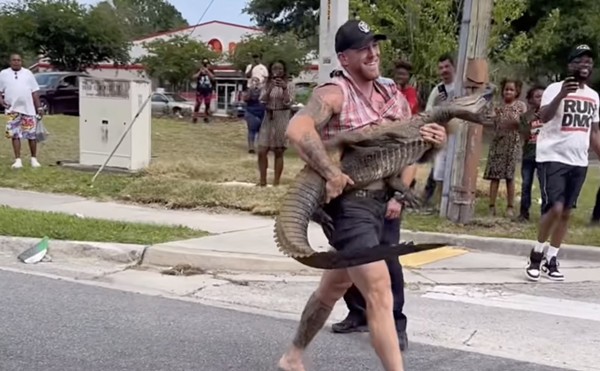The death chamber at Florida State Prison occupies two rooms, in mud/pastel tones common to all institutions. Like the rest of what visitors see of the prison, it's spotlessly clean. One room is for the 30 or so witnesses, who sit in four rows of chairs with roughly carved backs vaguely suggesting angels with outspread wings. The chair in front of me had the name "Cathy" carved into the back -- a strange place to memorialize someone, I thought as we waited for Allen Lee "Tiny" Davis to be brought in.
On the other side of a large glass window in the second room is the electric chair. The device rests close to the glass; the condemned man is in your face. But the rooms are carefully sealed off from one another. Corrections officials don't want witnesses to smell the cooking flesh.
A diagonal partition hides the executioner; a clock on the partition measures the final moments of life. One official has a phone to his ear, occasionally two phones, waiting, as in the movies, for the call that might come from the governor's office. This is Jeb Bush's first killing, however, and he's showing his mettle. There will be no mercy, despite pleas from clergy and from groups as diverse as the American Bar Association and Amnesty International to halt the tide of executions in Florida.
Nor will the world miss Allen Lee Davis. Fifty-four when the state killed him, the former Jacksonville welder might have died an unremarkable death but for the night of indescribable horror he orchestrated on May 11, 1982.
There's no doubt that on that evening Davis visited his parents' neighbor, Nancy Weiler, then 37, who was three months pregnant and whose husband was out of town. There's no doubt that Davis bludgeoned Nancy Weiler to death with a pistol, striking her so hard and so many times that her face was unrecognizable and the gun's trigger guard and frame were broken. There's no doubt that Davis shot and killed Nancy Weiler's oldest daughter, Kristina, who was on the eve of her 10th birthday, and then murdered the younger daughter, Katherine, 5, by crushing her skull and putting a bullet in her back as she tried to escape the nightmare.
Sixteen years ago a jury found Davis guilty of the loathsome deeds. Davis never expressed remorse.
John Weiler, the husband and father who lost so much that night, aptly described Davis as a "deviant animal," and recalled at a news conference last week that the killer admitted his motive was "to rape and kill my daughter Kristina, 9, then to murder my wife and younger daughter. A secondary motive was to rob my residence."
I watched Davis pay the temporal price for his deeds last week. I don't dispute John Weiler's anguished statements. Yet Weiler also said that "God approves" of the people of Florida killing Davis. At that, I am troubled. Whenever a state usurps prerogatives of meting out life and death, we're on desperately dangerous ground.
Here's what I saw:
Davis' 344 pounds of quivering, layered, no-sunshine-white flesh were rolled into Raiford's death chamber on a wheelchair. He had to be stuffed into a pair of blue pants and a white shirt. Guards man-handled Davis onto the state's new electric chair, dubbed "New Sparky" or "Son of Sparky" by those who think killing lends itself to humor.
Prison officials say condemned prisoners aren't sedated. Maybe. It is well known that John Spenkelink -- who in 1979 became Florida's first guest of the chair after a 15-year national moratorium on executions -- was given two slugs of Jack Daniels.
Davis seemed barely conscious when he took the stage for his last act. He appeared dazed, showing only intermittent interest as guards struggled to strap his ungainly bulk onto the wood frame. His weight already made him a grotesque. The shaved head lathered thick with a clear, electrically conductive gel, made him more so.
According to officials, Davis had been largely silent about the whole process. He spent his last hours reading a cowboy novel, "Day of the Half-Breeds," by someone named Peter McCurtin. His last meal was a lobster tail, a half pound of fried shrimp, six ounces of clam strips, fried potatoes, a loaf of garlic bread, melted butter and cocktail sauce, and 32 ounces of A&W root beer. He finished all but a little of the bread. He even gulped down the dregs of the drawn butter.
Davis had been slated to be No. 45 to die in Florida's chair since the death penalty was revived in 1979. That would have made him No. 240 since 1926. In both cases he moved up a notch when Thomas Provenzano, scheduled to be executed a day before Davis, won a delay. (That Provenzano is obviously nuts, and that civilized societies refrain from executing the insane, hasn't penetrated the state's barbaric mentality.)
I once worked at the Atlanta Constitution, where an old-timer liked to tell young journalists about the executions he had covered at Georgia's prison in Reidsville. He said the condemned man was hit with three separate cycles just to be sure no spark of life remained. One of the side effects, however, is that the prisoner's arm and leg joints would become fused, and guards had to use a sledgehammer to smash the recently deceased's limbs to remove him from the chair.
Horrible, I remember thinking. I didn't expect anything so traumatic with Davis. I had forgotten, however, that Florida has gained a national reputation for mismanaging and botching executions, from the accusations that Spenkelink was tortured by guards to the explosion of flame from Pedro Medina's head on March 25, 1997.
The final steps in the grim ceremony began when an official asked if Davis had a final statement. Davis shook his head: No. Guards then strapped onto him a conical helmet largely encased in a leather mask that, in turn, is covered by an opaque black veil.
Davis, at this point, roared twice. Some witnesses said he was screaming "help." I just heard noise. My speculation is that he either realized eternity might not be pleasant or, more likely, was feeling pain from straps and buckles biting into him. Maybe both.
When the power hit him, he lurched forward against the straps. Then the gruesome part began. Blood blossomed on his shirt front, growing to about the size of a large saucer. There was more blood around his collar.
Gene Morris, a spokesman for the Department of Corrections, has witnessed 16 executions. He said he had never seen such a thing happen. Ron Word, an Associated Press reporter, has watched 30 electrocutions. He has never seen bleeding.
The official spin from Bush's office and prison officials is that Davis had a nosebleed, caused by medicines that thinned his blood.
A nosebleed is not what I saw. For a brief moment, a medical technician lifted the black veil. There was a little trickle of blood around the mask, going to the shirt collar. There was certainly no big stream that could have caused the big pool on his chest.
State Sen. Ginny Brown-Waite, a supporter of the death penalty, was another witness, and she saw what I did. She told the Miami Herald: "I don't believe the blood came from the nose. He had on a white shirt and the blood suddenly appeared -- like a blot." Maybe a buckle had pierced Davis' chest. Maybe he had exploded inside.
There are other discrepancies with official reports. Lawyers for weeks have contended there wasn't enough electrical juice to instantly kill the bulky Davis. The cycle is supposed to be 2,300 volts for eight seconds, 1,000 volts for 22 seconds and a final 2,300 volts for eight seconds more. But records obtained by the Times-Union in Jacksonville show Davis received only 1,500 volts for eight seconds, 600 bolts for 22 seconds and 1,500 volts for four-and-a-half seconds.
The result? After the power was cut, his chest was heaving. The official blather was that it was a heart fibrillation. I don't think so. That guy was breathing. Could he feel pain? Officials say the process totally cooks the brain, with temperatures rising to 140 degrees and higher. The officials have, apparently, been wrong about other aspects of the event.
Many will say that, however ghastly the execution, Davis got off easier than those whose suffering he caused.
"Capital punishment is an intolerable denial of civil liberties and is inconsistent with the fundamental values of our democratic system," counters Howard Simon, executive director of the American Civil Liberties Union of Florida. "Criminals no doubt deserve to be punished, and the severity of the punishment should be appropriate to their culpability. But Florida's record of executions, and the Legislature's obsession with electrocution as the method of execution, has been barbaric."
The Florida Legislature delights in the savagery of capital punishment. The legislators think it wins votes at home. But when given the option of imposing a sentence of life without possibility of release, according to the ACLU, a majority of the public is willing to forego it.
No, we won't miss Davis. But we may someday miss the part of our soul that dies each time the switch is pulled.

















